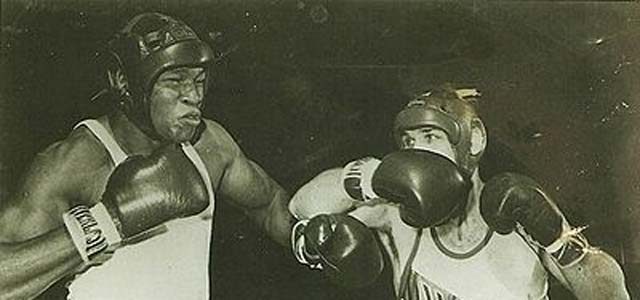Southpaw Nick Wells of the US Air Force stood 5′ 10″ and was facing 6′ 03″ Larry Holmes in their first encounter in the finals of a tournament in Minnesota in 1972. Wells would stop the future world professional champion in three rounds. Holmes excuse was he had no southpaw sparring. After getting some southpaw sparring they fought again in the semifinals of the 1972 U.S. Olympic trials in Fort Worth, Texas, and Wells stopped Holmes in the first round.
Wells’ first round stoppage was one of 72 knockouts in the first round and a total of 110 knockouts with an amateur record of 171-18. Holmes wrote of his bouts with Wells in his 1998 autobiography, Larry Holmes: Against the Odds:
“By 1972 I’d won several eastern titles and was invited to Minnesota to compete in a tournament that was said to figure heavily in the selection of the U.S. boxing team. I made it all the way to the finals there, only to run up against a left-handed slugger named Nick Wells. It was the first time I’d fought a lefty. It threw my reactions off. I was hesitant and ended up being an easy target for Wells, who had good power. Good enough to give me the worst beating of my career and stop me in the third round. My first-ever defeat. The way things unfolded I had another opportunity against Wells in a later tournament in Texas. This time I managed to find left-handed sparring partners to get ready for him. Guess what? It didn’t matter. Not one bit. That guy Wells had my number, and he beat me again. Badly.”
Wells was cut prior to the tournament starting doing horse play then lost to Duane Bobick in the finals of the 1972 U.S. Olympic trials. Bobick had defeated Wells three times previously. The first round opened with Bobick continually landing his forceful jabs on Wells’ head. Wells was obviously softening fast. But midway through the first round Wells caught Bobick with a steaming left to the face and suddenly the game was on. The two stood toe to toe in the middle of the ring for the duration of the round and Wells came out of it with a bloody right eye. In the second round both fighters tired rapidly, with Wells appearing almost out on his feet at the round’s end. Bobick was not a lot better. Wells eye cut had been reopened and he had a bad cut on his lip. Bobick was bleeding heavily from his nose (broken) and a welt had been raised over his left eye. Blood smeared both boxers, the referee, the ring and even a few ringside spectators. The cut over Wells eye was so deep the referee, after taking one look at it at the close of round two, stopped the bout.
Wells received six stitches over his right eye and three on his lip. Due to the cuts, he was unable to box in the U.S. Olympic box-offs in West Point, NY, two weeks later. He was a five-time Fort Worth Golden Gloves champion. Two-time Star-Telegram Texas State GG champion. He was the Texas state champion in 1969, 1970 and 1971. 1972 he was the National AAU champion. He was the 1972 CISM World Military Boxing Championships Gold Medalist. He was the All-Air Force champion in 1972, 1973, 1974, 1975 and 1976. He was the Nevada State GG champion in 1972 and 1973. Finally, he was the inter-service champion in 1973 and 1975. “Wells could fire up a crowd, turn out the lights,” said Jim Reeves. (Fort Worth Star-Telegram, July 7, 2007.
Wells turned professional in October 1976 at the age of 25. He had an opportunity to be trained by Lou Duva but ended up going with local trainer and promoter Winky Groom, under whom he was not able to achieve contender status. He stopped his first four opponents before running into Mike Koranicki, 16-3-1, being stopped in the ninth round. It was rushing him too fast into a ten round bout in only his fifth fight by his promoter.
Wells would follow his first loss with five knockout wins before appearing on the big stage at Madison Square Garden to face G.G. Maldonado, 11-6-2, who was the first opponent to outweigh him. Wells would lose over eight rounds. Just eight days later in Orlando, Florida, he took an eight round split decision over Curtis Gaskins, 2-0.
Four weeks after that encounter Wells lost to a much lighter James Dixon, 8-9-1, over ten rounds. Then he faced Cookie Wallace, 22-30-2, who had been thrown to the wolves facing such fighters as George Foreman, Mac Foster, Bob Foster, Ken Norton, Oscar Bonavena, Al Jones, Earnie Shavers, Scott LeDoux, the Bobick brothers Duane and Rodney, John Tate and he split with Johnny Boudreaux, 21-3, in their second encounter. Wells would lose being stopped in the ninth round for the USA Texas title. He would go onto win five of his next eight fights by knockout before retiring in April of 1983. After retiring he became a fire captain for the Fort Worth Fire Department and a security guard. “My son told me I wasn’t going to be successful as a part-time professional,” said Wells. My wife Denise and I have been married 33 years and I have a daughter Hayley and a son Nickolas and daughter Halley. Also 3 grandsons the oldest Koltyn now going to U. of Texas, Caden a sophomore at Burleson H.S. and the youngest is Braxon. Wells would end his professional career with a 15-7 record with 14 knockouts at the age of 32. “Maybe I was fortunate. I got out of it without having my bell rung too much. I didn’t take a lot of punishment. I did take some. Everybody does,” said Wells.
The only time this writer saw Wells fight was in the amateurs when he knocked out big Leroy Jones of Denver in the first round. Then he fought Jones in Boston winning a decision. He would go onto have a record of 25-1-1 in the professional ranks only losing to Holmes in a WBC world title fight while suffering a detached retina. Wells still wonders what would have happened if he signed with Duva.
KEN HISSNER: You had an outstanding career as an amateur but like many had one nemesis that being Duane Bobick.
NICK WELLS: I lost to him four times. In one of our fights in a semi-final I was off balance and got hit on the shoulder and went down and the referee Stan Hamilton called a halt.
KEN HISSNER: Did you have more than one trainer in the amateurs?
NICK WELLS: Frankie Carr who I won 3 titles with. Then Gene Cooper in the Air Force.
KEN HISSNER: When I called you after getting your phone number from former Air Force and Olympian Jesse Valdez I couldn’t have been more pleased talking to the man who stopped Larry Holmes, not once but twice. That had to be a big highlight of your career in looking back on it.
NICK WELLS: I knocked out Scott LeDoux.
KEN HISSNER: Do you think your promoter pushed you too fast fighting a 20 bout vet in Koranicki in the fifth fight of your career?
NICK WELLS: He had a better jab than Holmes.
KEN HISSNER: Having 207 amateur fights stopping 72 of your opponents in the first round would you say it didn’t prepare you for the professional ranks especially starting with ten round bouts after only four fights?
NICK WELLS: Helped my punching ability but they being on 3 rounds didn’t prepare me for the professionals.
KEN HISSNER: You and Jesse Valdez were in the Air Force together for a bit. Your brother also served with Jesse you told me. Did you have the same trainer he did?
NICK WELLS: Yes he did.
KEN HISSNER: About a year ago I had the pleasure of heckling Holmes at a press conference he was having for his “one man show” and I brought up your name having beaten him twice. I loved it and wish you’d been there. He asked if I knew who else beat him after his losses to you and he said Duane Bobick because he (Holmes) was only a light heavyweight. What do you think of that?
NICK WELLS: He was 200 pounds.
KEN HISSNER: I remember meeting Michael Spinks who ended Holmes 48 straight winning streak. Along with you defeating Holmes those were some great memories for me. I want to thank you for taking the time to answer some questions Nick.
NICK WELLS: I can’t believe after all these years I’m still a subject talked about.


